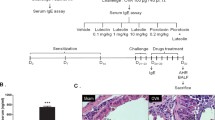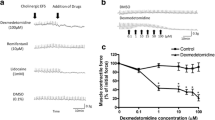Abstract
Leukotrienes (C4, D4) have been shown to enhance mucus seeretion in both isolated human airway tissue and intact canine tracheain vivo. They also have been implicated as putative mediators in several airways diseases. In previous canine studies the mucus enhancing effect of leukotriene-C4 was blocked by atropine, FLP 55,712, and hexamethonium but not by cutting the superior laryngeal and vagus nerves. We anesthetized mongrel dogs with chloralose (100 mg/kg) and urethane (500 mg/kg) and ventilated them on a pump. To visualize the secretions from submucosal glands, we exposed the mucosa of the upper trachea and coated its surface with powdered tantalum. Seeretions from the glands formed elevation in the tantalum layer (hillocks) with time: the number of tracheal hillocks (an index of mucus secretion) was measured at one or more of the four time points on six dogs after each treatment of the treatment sequence: no LTC4, LTC4, no LTC4+ blocker, and LTC4+ blocker. The potential blocker was diphenhydramine, an H1 antagonist for histamine. LTC4 was injected into the cranial thyroid artery which directly feeds the tracheal segment. We observed hillocks through a dissecting microscope, and the number of hillocks per 1.2 cm2 were counted for a 1–4 min interval. In 6 dogs with 12 responses, LTC4 (10 μg) gave a positive response that was significantly different from control (p<0.01–0.05) at 2–4 min.
Diphenhydramine (n=6), 0.5 mg/kg, a dose which blocked a histamine challenge without blocking an acetylcholine challenge of secretion, gave a statistically significant (p<0.01–0.05) reduction in mucus secretion at 1–4 min. These results support the conclusion that leukotriene C4 induces mucus secretion in dogs that is blocked by prior diphenhydramine administration. This would indicate histamine has a role, but as yet an unknown mechanism in the action of leukotriene-C4 in enhancing mucus.
Similar content being viewed by others
References
J.T. Gallagher, P.W. Kent, M. Passatore, R.J. Phipps andP.S. Richardson,The composition of tracheal mucus and the nervous control of its secretion in the cat, Proc. R. Soc. London (Biol.)192, 49–76 (1975).
B. Davis, M.G. Marin, S. Fischer, P. Graf, J.G. Widdicombe andJ.A. Nadel,New method for study of canine mucus gland secretion in vivo: cholinergic regulation, Am. Rev. resp. Dis.113, 257, Abst. (1976).
J.H. Shelhamer, Z. Marom andM. Kaliner,Immunologic and neuropharmacologic stimulation of mucus glycoprotein release from human airways in vitro, J. clin. Invest.66, 1400–1408 (1980).
Z. Marom, J.H. Shelhamer andM. Kaliner,The effects of arachidonic acid, monohydroxyeicosatetraenoic acid, and prostaglandins on the release of mucus glycoproteins from human airways in vitro, J. clin. Invest.69, 1695–1702 (1981).
B.A. Jakschik, L.H. Lee, O. Shuffer andC.W. Parker,Aarchidonic acid metabolism is not basophilic leukemia (RBL-1) cells, Prostaglandins16, 733–748 (1978).
L.J. Roberts, R.A. Lewis, J.A. Oates, andK.F. Austen,Prostaglandin, thromboxane and 12-hydroxy 5,8,10,14-eicosatetraenoic acid production by ionophore stimulated art aerosal mast cells, Biochim. biophys. Acta575, 189–192 (1979).
M. Hamberg, P. Hedqvist andK. Rodegran,Identification of 15-hydroxy 5,8,11,13-eicosatetraenoic acid (15-HETE) as a major metabolite of arachidonic acid in human lung, Acta physiol. scand.110, 219–221 (1980).
R.C. Murphy, S. Hammerström andB. Samuelsson,Leukotriene C: a slow reacting substance from murine mastocytoma cells, Proc. natn Acad. Sci. USA76, 4275–5279 (1979).
J.A. Nadel,Autonomic Control of airway smooth muscle and airway secretion, Am. Rev. resp. Dis.115, 117–126 (1977).
L. Platshon, andM.A. Kaliner,The effect of the immunologic release of histamine upon human lung cyclic nucleotide levels and prostaglandin generation, J. clin. Invest.62, 1113–1121 (1978).
Z. Marom, J.H. Shelhamer, M.K. Bach andM.A. Kaliner,Slow-reacting substances LTC 4 and LTD 4 increase the release of mucus from human airways in vitro. Submitted to Am. Rev. resp. Dis.
J.A. Nadel, B. Davis andR.J. Phipps,Control of mucus secretion and ion transport in airways, A. Rev. Physiol.41, 369–381 (1979).
S.E. Dahlen, P. Hedqvist, S. Hammarström andB. Samuelsson.Leukotrienes are potent constrictors of human bronchi, Nature288, 484–486 (1980).
H.G. Johnson, R.A. Chinn, A.W. Chow, M.K. Bach andJ.A. Nadel,Leukotrienes C 4 enhances the release ofmucus from submucosal glands in canine trachea in vivo, INT. J. Immunopharmacol submitted (1982).
H.L. Hahn, A.G. Wilson, P.D. Graf, S.P. Fischer andJ.A. Nadel,Interaction between serotonin and efferent vagus nerves in dog lungs, J. appl. Physiol.44(2), 144–149 (1978).
G.K. Adams, andL.L. Lichtenstein,In vitro studies of antigen-induced bronchospasm: Effect of antihistamine and SRS-A antagonist on response of sensitized guinea pig and human airways to antigen, J. Immun.122, 555–562 (1979).
Author information
Authors and Affiliations
Rights and permissions
About this article
Cite this article
Johnson, H.G., Chinn, R.A., Morton, D.R. et al. Diphenhydramine blocks the leukotriene-C4 enhanced mucus secretion in canine tracheain vivo . Agents and Actions 13, 1–4 (1983). https://doi.org/10.1007/BF01994273
Received:
Issue Date:
DOI: https://doi.org/10.1007/BF01994273




